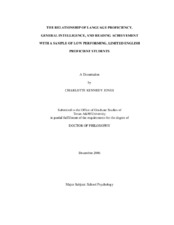| dc.description.abstract | The present study had three purposes. The first was to examine the score
reliability of instruments purported to be appropriate in the assessment of students with
limited English proficiency (LEP). The second was to investigate the criterion-related
validity of the Universal Nonverbal Intelligence Test (UNIT) with a sample of lowperforming,
Hispanic students. The third purpose was to explore the contribution of
language proficiency in the dominant language (L1) and the language proficiency in the
subordinate language (L2) in the prediction of reading achievement in L1. Participants
included first and third grade students of Hispanic origin who scored below the median
for their district on a state-approved, district-administered measure of literacy in first
grade.
Satisfactory internal consistency estimates were achieved with a sample of LEP
students (n=24) on the UNIT, the Woodcock-Muñoz Language Survey (WMLS) in
English and in Spanish, and the Batería Woodcock-Muñoz: Pruebas de
Approvechamiento-Revisada (Batería-R APR). For first grade students, scores from the
UNIT demonstrated satisfactory concurrent validity with those from the Woodcock Johnson III: Tests of Achievement (WJ-III ACH) for a sample of Hispanic, non-LEP
students (n=89). However, the concurrent validity of the UNIT was not upheld for a
sample of Hispanic, LEP students administered the Batería-R APR (n=56). Regarding
predictive validity, results from simple linear regression analyses suggested that
performance on the UNIT in first grade accounted for a negligible portion of the
variance on the Texas high-stakes reading test in third grade for a group of LEP students
(n=51) as well as for a group of non-LEP students (n=77). Language proficiency in L1
emerged as a positive predictor of reading achievement in L1. However, language
proficiency in L2 was not shown to be a statistically significant, independent contributor
to this relationship with reading achievement on the Batería-R APR (n=79), WJ-III ACH
(n=14), TAKS Spanish (n=54), or TAKS English (n=12). Findings are discussed with
respect to the restriction of range due to selection criterion and sample size, the use of
the Abbreviated battery of the UNIT in the prediction of reading achievement, and the
contribution of language proficiency in L2 for low performing, LEP students in the third
grade. | en |


